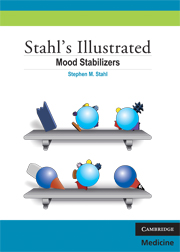Book contents
- Frontmatter
- Preface
- Contents
- CME Information
- Visual Vocabulary Legend
- Objectives
- Chapter 1 Symptoms and Spectrum of Bipolar Disorder
- Chapter 2 From Symptoms to Circuits
- Chapter 3 From Circuits to Mechanisms
- Chapter 4 Lithium and Various Anticonvulsants as Mood Stabilizers for Bipolar Disorder
- Chapter 5 Atypical Antipsychotics as Mood Stabilizers for Bipolar Disorder
- Chapter 6 Building a Treatment Plan
- Summary
- Addendum
- Abbreviations
- Suggested Readings
- Index
- CME: Posttest and Certificate
Chapter 2 - From Symptoms to Circuits
Published online by Cambridge University Press: 22 October 2021
- Frontmatter
- Preface
- Contents
- CME Information
- Visual Vocabulary Legend
- Objectives
- Chapter 1 Symptoms and Spectrum of Bipolar Disorder
- Chapter 2 From Symptoms to Circuits
- Chapter 3 From Circuits to Mechanisms
- Chapter 4 Lithium and Various Anticonvulsants as Mood Stabilizers for Bipolar Disorder
- Chapter 5 Atypical Antipsychotics as Mood Stabilizers for Bipolar Disorder
- Chapter 6 Building a Treatment Plan
- Summary
- Addendum
- Abbreviations
- Suggested Readings
- Index
- CME: Posttest and Certificate
Summary
This chapter introduces the brain circuits involved in depression and mania as well as some commonly associated symptoms. Understanding the neurobiological nature of an illness is the first step in deciding how to treat it. Identifying circuits that hypothetically correspond to the major symptoms of mania and depression becomes especially critical when attempting to establish pharmacologic parallels to treat those symptoms. Although much is still unknown about the aberrant circuitry in bipolar disorder, the brain regions and circuits that are theoretically involved are under intense investigation. The biological basis of symptoms commonly observed in bipolar disorder are presented as the second step in the symptom-based algorithm discussed here, namely, matching symptoms to hypothetically malfunctioning brain circuits. This algorithm, a simplified version of reality, is complicated by another concept presented in this chapter: the bipolar storm. This concept illustrates the hypothesis that bipolar disorders may not be the result of one or several irregular neural circuits, but rather a manifestation of unstable and/or excessive neurotransmission more generally. Following this logic, mechanisms involved in neurotransmission, such as ligand- and voltage-gated ion channels, are presented in Chapter 3 and may help explain the efficacy of drugs that act on these neurotransmission mechanisms.
Delusions and hallucinations are linked primarily to the NA; aggression, hypersexuality, and substance abuse are mediated by both the NA and the PFC. The PFC may play a role in impulsivity and overactivity; overactivity is also associated with the striatum. Anxiety may occur in bipolar disorder and is primarily mediated by the amygdala.
- Type
- Chapter
- Information
- Stahl's Illustrated Mood Stabilizers , pp. 17 - 28Publisher: Cambridge University PressPrint publication year: 2009



